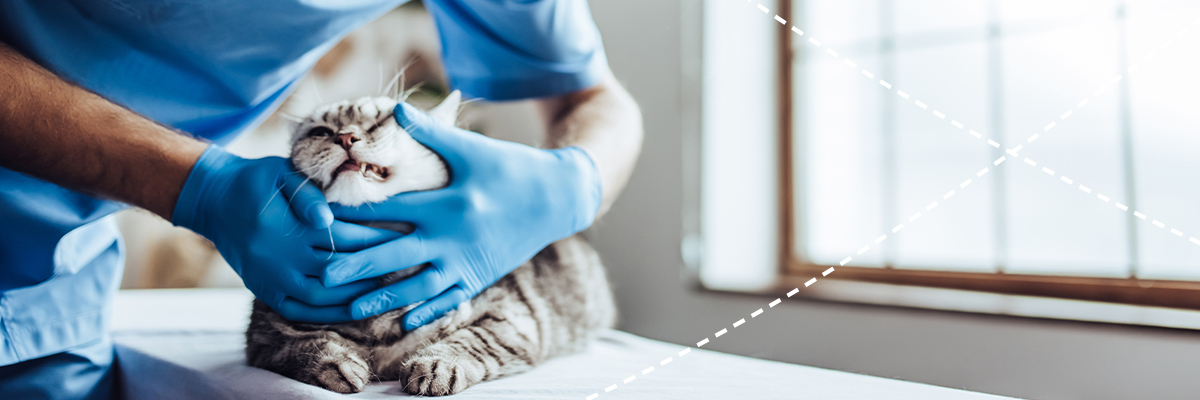
Summary
- many cats do not receive regular health checks or preventive measures
- early intervention in early stages allows slowing down of progression
- Health checkups should be performed regularly from the age of 7 years
In a Belgian study from 2015, 5,305 dogs and cats were given a free health check at the vet of their choice.
This precedent-setting project revealed that of the 2,260 cats examined, 36% were overweight and 21% already had dental conditions. 67% of the cats had no flea and tick protection and 59% had not been vaccinated. The authors refer to that only about 25-30% of domestic cats in Belgium receive veterinary care. Therefore, it is not surprising that such few cats were properly cared for against diseases and parasitic infestations. At the same time, 36% of the participating cats were already over 7 years old. It is equally unsurprising that only 31% of the cats examined in the study were healthy. 69% had at least one health issue, including flea or other parasite infestation requiring treatment. Cats in particular were more likely to have poor oral health: Dental mucosal inflammation (= gingivitis) and dental lesions were the most common. But also renal diseases were unobserved and untreated.
Cat owners cannot notice everything
However, veterinary prevention in cats includes more than just vaccinations and deworming. Prevention also includes dental checkups and geriatric screenings. They are important to improve life (increase quality of life) in older cats and, if possible, to prolong it. Preventive measures can detect diseases unnoticed by the cat owner. Such diseases can then be treated and managed at an earlier stage.

Early detection of CKD
Health checkups should be performed regularly from the age of 7 years. Since every third cat over the age of 10 is affected by chronic kidney disease (CKD), it is worthwhile to intervene in time and to have the kidney profile with creatinineCreatinine is a breakdown product of muscle metabolism. Its blood level is dependent, among many factors, on age, weight, nutritional status and muscle mass. Hence, creatinine levels in the blood vary from individual to individual. Creatinine is continuously excreted in the urine. Increased blood creatinine..., ureaUrea is the nitrogen-containing breakdown product of protein metabolism. The nitrogen from the proteins is converted to ammonia in the liver, which is combined with carbon dioxide to form urea. This is continuously excreted via the kidneys but also via sweat. Urea is one of..., phosphate checked regularly and the SDMASDMA = Symmetrical Dimethylarginine, which is a degradation product of the amino acid arginine and is excreted solely through the kidneys. SDMA is a highly specific biomarker for kidney function in cats. Read more: SDMA test (blood test)... test performed at the latest from the age of 7. Dental problems (especially FORL= Feline Odontoclastic Resorptive Lesion = degradation of the tooth by the body's own cells which destroy the tooth....) and kidney disease are closely related. So are kidney disease and blood pressure, which is elevated in cats with chronic kidney disease. In addition, high blood pressure leads to progression of CKD. Therefore, especially in middle-aged and old cats, blood pressure measurement is an important preventive measure for kidney health. However, blood pressure measurement in cats is difficult because many cats become anxious in the vet’s office, causing their blood pressure to rise.

Clinical symptoms of CKD: invisible until it is (too) late
Since the first symptoms of chronic kidney disease are unspecific and only appear when 2/3 to ¾ of the kidney tissue has already been irreversibly destroyed, the above-mentioned blood tests can often provide the first indications of a beginning CKD. If CKD is detected early, measures can be taken to preserve the cat’s quality of life for a longer period of time. In addition, early detection can also contribute to a slowing down of the progression of chronic kidney disease and thus to a prolongation of life with the measures then initiated at an early stage.
Bibliography:
- Diez, M. / Picavet, P., Ricci, R., Dequenne, M., Renard, M. / Bongartz, A. & Farnir, F. (2015), In: Journal of Small Animal Practice, Vol. 56, S. 463–469.


